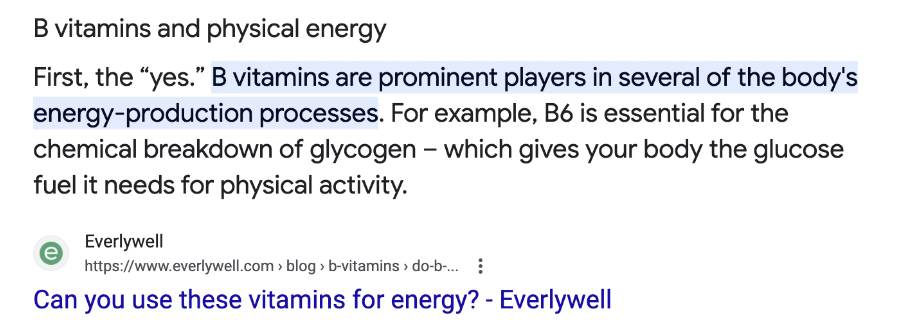It’s a typical Sunday. You need to pick what you’re going to eat for the week, so you google “easy weeknight dinners.” A bunch of highly-rated recipes pop up, and you click on the first one.
While the photo of those sheet pan pork chops looks delicious, when you get to the site there’s so much text before the actual recipe. Which makes you wonder— why do food bloggers feel the need to tell their life story in every post?
Food bloggers write long stories before recipes because it boosts their SEO (search engine optimization). These paragraphs are full of keywords that tell Google they have the best easy weeknight dinners.
Blogs are one of the best tools in your toolbox to upgrade your SEO.
Writing keywords into blog posts helps your articles show up first on the search engine results page (SERP), which is the list of websites that appear after you Google anything. The earlier your business shows up on SERP, the more likely people are to visit your website.
Once you have your list of keywords (which we talked about in our last e9 digital’s Top SEO Tips post), it’s time to buckle up and start writing.
Bring Out Your Inner Blogger
Blogging has been around since the 90s, and you too may have some Open Diary, Xanga, or LiveJournal content that you can never purge from the internet. That’s okay: you created content once before, that means you can do it again.
It’s time to bring out that inner blogger to improve your ranking on Google’s SERP.
Earning a #1 spot on Google’s SERP earns your business a “halo of legitimacy.” Even if your company gains most of its leads through word of mouth, you still need to rank high on Google.
When your business gets recommended to someone, the first thing that person is going to do is google you. If you don’t show up on the first page, or your competitor ranks before you, people may question if you’re the right person for the job.
Blogs are your chance to show your expertise on a subject. When you write helpful content, you prove to Google that you’re a leader in your industry. This essentially means the algorithm will funnel more traffic to your website and you can earn that #1 spot.
5 Tips to Take Your Blogs from Boring to Blockbuster
Blogging can be fraught with challenges. You shouldn’t just type a phrase into ChatGPT and post whatever it barfs out.
Chat GPT has been shown to write incorrect facts and discriminatory answers, plus it can’t synthesize information for a bespoke, interesting argument like a human can. And it certainly can’t include keywords seamlessly for SEO.
Instead, strategically craft blog posts so they answer questions based on common queries with your target audience and format them to match Google’s needs.
1. Give the People What They Want: In-Depth Info
People won’t read a blog post that’s so stuffed with keywords it sounds like it was written by an alien from Mars.
Instead, pick topics that answer common questions from your customers. Blog posts should be in-depth enough to offer unique information that can’t be found anywhere else but simple enough to easily answer search queries.
When writing blog posts and other types of content, follow the three benchmarks Google uses to judge a blog post, commonly referred to as Google’s EAT strategy. EAT stands for
- Expertise
- Authoritative
- Trustworthy
Expertise conveys how much you know about your industry.
Prove to people that you know what you’re doing by posting case studies of past client success stories or sharing helpful how-to guides that solve specific problems. Include unique information or data that you’ve collected to create insightful content that can’t be found elsewhere.
Authoritative means that you’re following up what you say with proof.
When writing blog posts, you should link to credible sites. This could include other people in your industry, news publishing sites, or studies. You should also backlink to relevant blog posts on your site to share more valuable information related to the topic at hand.
Trustworthiness indicates that past customers are satisfied with your product or service.
Positive reviews and testimonials show Google that what you say on your website is actually true. Include quotes from customers on web pages or in blog posts. If you don’t have any reviews, include a survey link to leave a review on your site or send one out to your email newsletter.
Creating quality content with EAT signifies to Google that you are an expert that answers people’s questions, placing you on track to rank in the top ten of Google’s SERP.
2. Include Everyone: Optimize Images for SEO and ADA Compliance
Blog posts need images because they keep readers engaged. Any blog post that has more than seven images gets 116% more organic traffic.
Boost your blog’s credibility by formatting images so that Google can crawl them.
“Crawling” is the term for Google’s algorithm for finding and parsing your content for the SERPs. When uploading photos to your blog, be sure to use keywords in the file name and ALT text.
- The file name should include your keywords with hyphens.
- The ALT text is 10 to 15 characters describing what your image shows.
But alt text doesn’t just help with SEO. You must use ALT text for ADA website compliance. For anyone looking at your site with vision disabilities, this text can be read aloud so they understand the picture.
e9digital dove deep into the necessity of ADA website compliance. The internet should be an inclusive place, and creating websites that service visually impaired customers, employees and job seekers is simply the right thing to do.
Every business or government website must be ADA-compliant. The ADA rules change frequently, so reach out to a website design agency that can help you with regular audits to remain compliant.
3. The Smartest Person in the Room: Featured Snippets
Everyone wants to be the go-to guy on a certain subject. If you want to dazzle readers with your intellect, now you can with Google’s featured snippets.
These show up in Google’s search results as an answer to a query. Say someone googles, “Does vitamin B give you energy?” The first result on the page is a short paragraph that answers that question with a link to click to learn more.

To boost your SEO ranking, write blog posts where parts of the blog could answer featured snippets. For these sections, use keywords and make the answer to the question 40 to 50 words long.
4. Work Smart, Not Hard: Refresh Old Content
Times change. Information and content that was relevant five years ago quickly become outdated.
No one wants to watch an old VHS, they want to view movies on Blu Ray or 4K discs for the crisp colors and dynamic sound. To keep your content fresh, you need to update your VHS tapes (AKA your old blogs) and rewrite the content so it reflects new information.
And if an old blog post is no longer relevant, then you need to remove it from your website.
Most blog posts gain the most value within six to 20 months of the time they’re posted.
Anything after that is old news. So, take a look at your archives and rewrite content that’s been live for about 15 months.
This might seem daunting but it makes the work easier for you in the long haul.
Instead of constantly having to come up with new content, you can add in reworked old content with fresh keywords. Reposted blogs will drive more traffic to your site and take less time than writing a new blog from scratch.
5. Don’t Forget the Tech: Befriend BERT
There’s a new sheriff in town, and it’s called BERT (short for Bidirectional Encoder Representations from Transformers). BERT is a relatively new algorithm that helps Google’s search engine understand the intent of a search.
In previous search engines, the words were taken in a one-by-one order. But now, BERT can begin to understand what people actually want when they search for something. This means that the results that show up first are more likely to be accurate.
The most important thing about BERT is that you need to write quality content that solves problems. Do not write your content solely for SEO purposes. Write content that your audience actually needs to learn.
There are a few formatting tips to help BERT use your blogs.
- Write short content that quickly answers a search query
- Complete on-page SEO including title tags, SEO, meta descriptions, and more
- Use simple language that any person could understand
Blog posts are not the place to try to become the next William Faulkner.
Skip the flowery, elevated language and just make it easy for people to find the answer to their queries.
It takes time to build a website that shines in SEO. If your website is a skyscraper, the initial design is the foundation. Then, you need to write SEO blogs and web pages to build the building floor by floor until it becomes a skyscraper that everyone on the internet can see.
Blog your way to #1 with e9 digital. We’re a full-service web design and marketing agency that can handle every step of the process of building your internet skyscraper, including
- Website design and creation
- Ongoing SEO, including blogs and PPC ads
- ADA compliance
Learn why our past clients said that their “web presence and revenue have increased dramatically by working with e9” and request a call with our team today.
And be sure to read our next blog in the e9 digital’s Top SEO Tips series, where we go over the best practices for websites.
